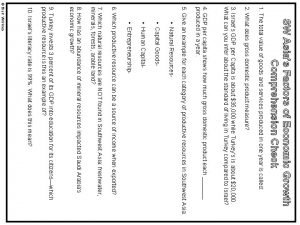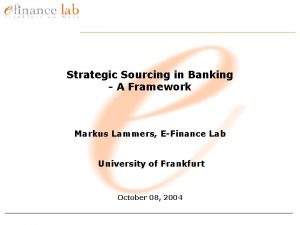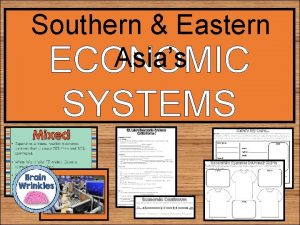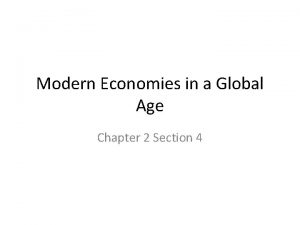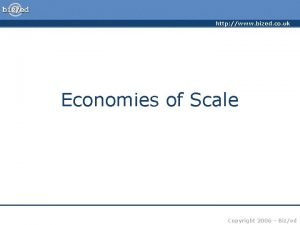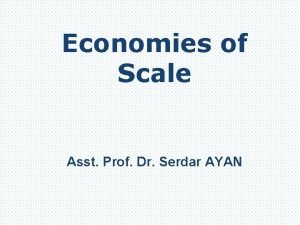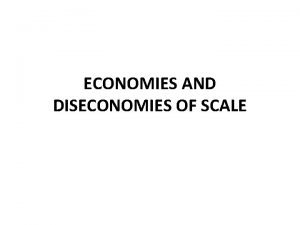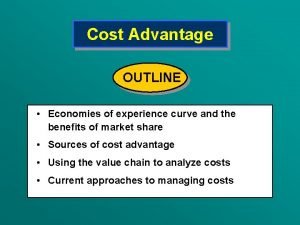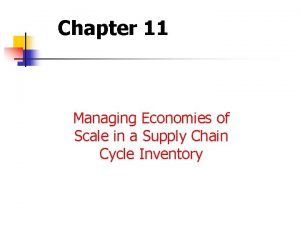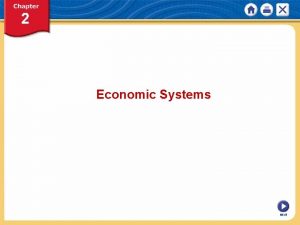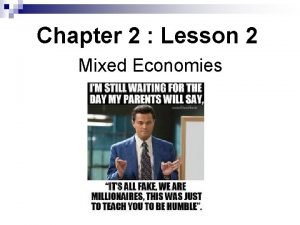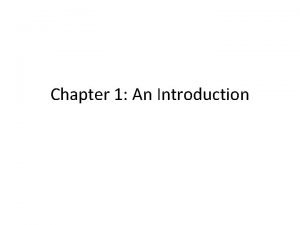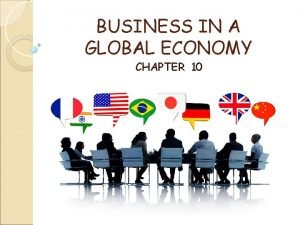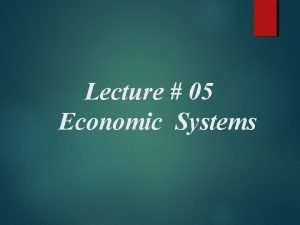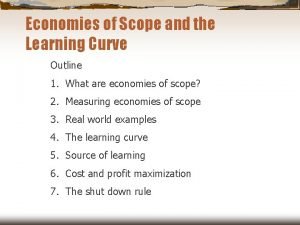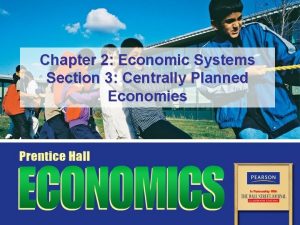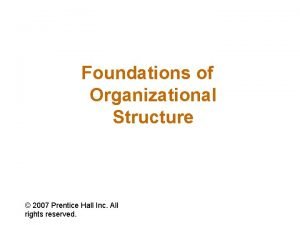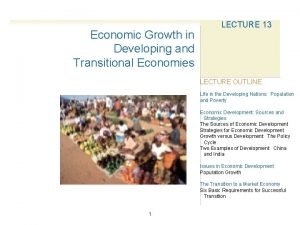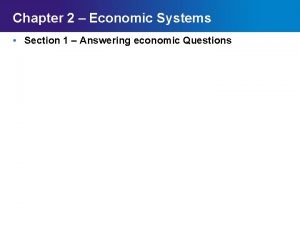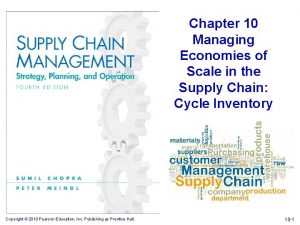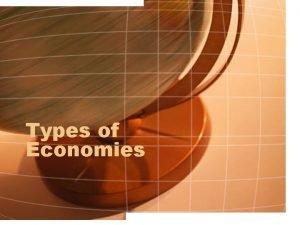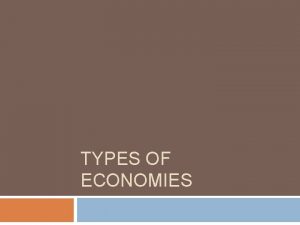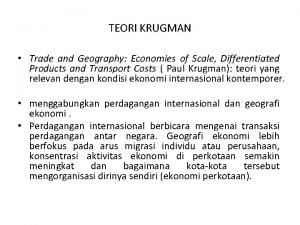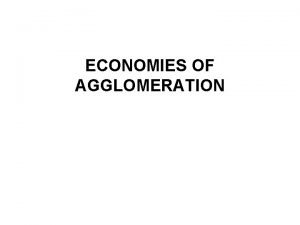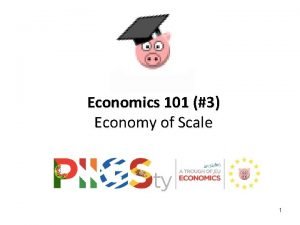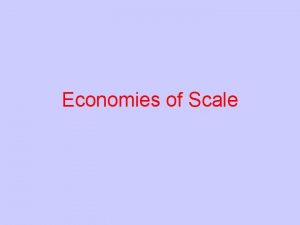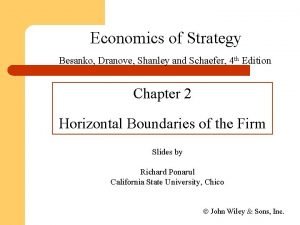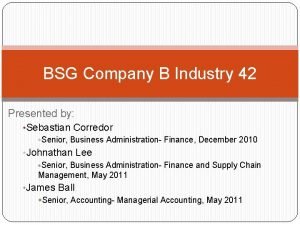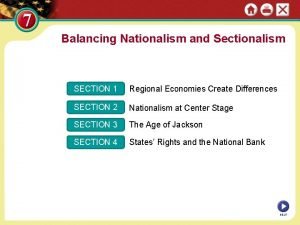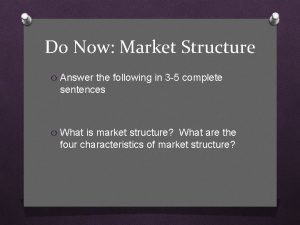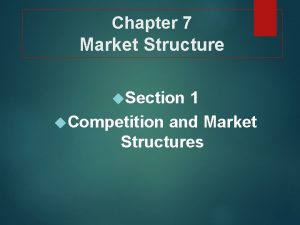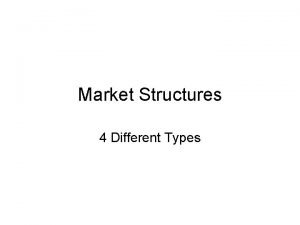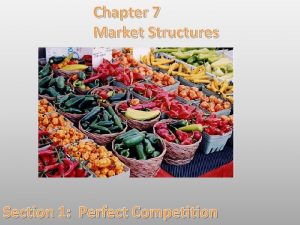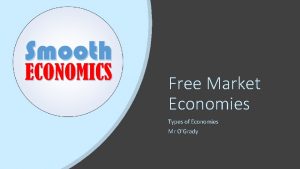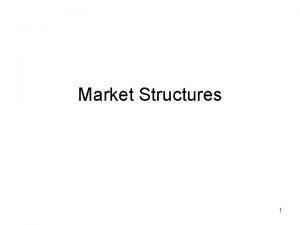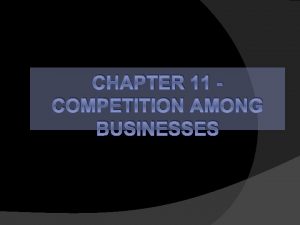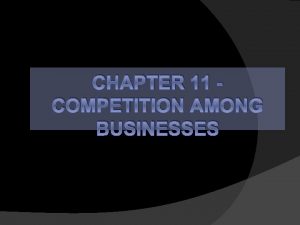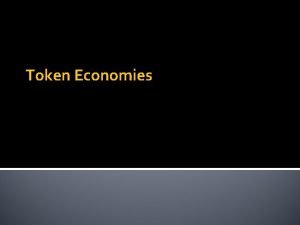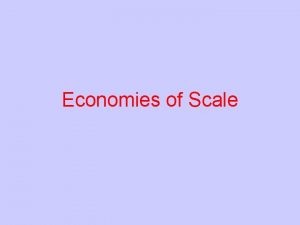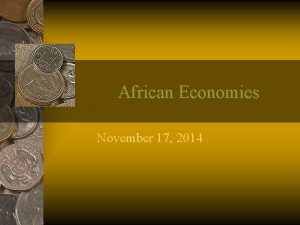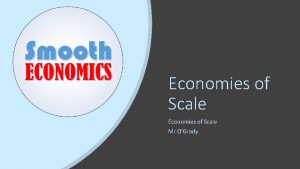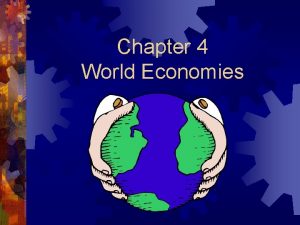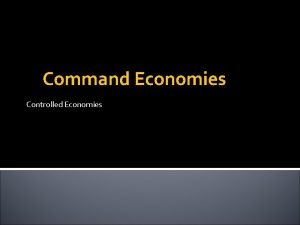Standard 3 Market Structures Market economies are characterized






















































- Slides: 54

Standard 3 Market Structures

Market economies are characterized by competition • The effort of two or more people, acting independently, to get the business of others by offering the best deal – Example: Macintosh and Windows PC

Monopoly • Only one seller- a single business controls the supply of a product that has no close substitutes • Control of prices- monopolies act as price makers because they sell products that have no close substitutes and they face no competition • Restricted, regulated market- government regulations or other barriers to entry keep other firms out of the market

Oligopoly • Few sellers- only a few businesses dominate an entire market • Products can be – Standardized (identical) –ex. Steel, aluminum – differentiated products (different characteristics, quality, function) • More control of prices- decisions one seller makes may cause the other sellers to respond in the same way • Little freedom to enter or exit markethigh start up costs

Challenge Question 1. Are Microsoft and Apple monopolies or oligopolies? 2. Is Citizen’s Water, the only water company in Indy a monopoly or oligopoly?

Dinner for 2 at the Cheesecake Factory $60

Dinner for 2 at St. Elmo’s $120

2 Tickets to see your favorite basketball team $100

Colts Season Tickets $1500

2 Tickets to go see your favorite band or musical $100

Monopolistic Competition • Many sellers- sellers act independently in choosing what kind of product, how much and what price • Similar but differentiated products (ex. hamburger restaurants) • Limited control of prices- consumers will switch to a substitute if the price goes too high • Freedom to enter or exit market- relatively easy to start a small business, if it does not work, equipment can be sold

What makes these restaurants different? • Quality and characteristics of food (non-price competition)

Pure competition • Many buyers and sellers- a large number of buyers and sellers ensures that no one controls prices • Standardized product- all products are essentially the same • Freedom to enter and exit markets- producers can enter or exit the market with no interference • Independent buyers and sellers- buyers and sellers do not band together to influence prices • Well-informed buyers and sellers- both buyers and sellers know the market prices and other conditions

Challenge Question 1 and 2 1. Is pizza normally bought from companies engaged in monopolistic competition or pure competition? 2. Is wood normally bought from companies engaged in monopolistic competition or pure competition?

Challenge Questions 3 -6 What market structure matches the example? 3. Chinese Food- #1 Chinese Buffet, China King, Side Wok Café, King Dragon, Tiger Lily 4. Lettuce 5. Lucy’s gas station, which is the only gas station within 100 miles of her town 6. Coke and Pepsi

Impact of Monopolies, Regulation and Deregulation

Predict • Why do you think monopolies could be bad?

Why could it be considered bad to have a monopoly? • Monopolies have extensive control over price without competition- when paired with inelastic demand it could be really bad. • Inequality of wealth developsreally rich and really poor • Wealthy companies can buy out other companies and create monopolies in multiple industries

Predict • How could monopolies be good?

Read 7. 2 and complete notes

Reading Check- Cartels • Explain why OPEC would be classified as a cartel. – Oil producing countries act together to set prices and control the supply of oil. • Ex. 1973 oil crisis – OAPEC oil embargo due to US military support for Israel – Decreased supply and high prices caused economic recession

Reading Check- Natural Monopoly • Example • Water Company • Why is there only one seller? • Costs are more efficient with one supplier • Why is the market restricted? • Economies of scale- cheaper to produce when larger because can spread fixed costs over larger population of buyers • How does it have control of prices? • Prices subject to government regulation- ensure they don’t charge too much

Reading Check- Government Monopoly • Example • The Postal Service • Why is there only one seller? • Can’t be provided by private terms, not attractive bc insufficient profit • Why is the market restricted? • Market entry limited by government control • How does it have control of prices? • Prices determined by government regulation

Reading Check- Technological Monopoly • Example • Polaroid • Why is there only one seller? • Ownership of invention/technology • Why is the market restricted? • Patents cause a barrier to entry (kept Kodak out of instant camera business) • How does it have control of prices? • Charges higher prices while the monopoly lasts

Reading Check- Geographic Monopoly • Example • Professional Sports/ only gas station in town • Why is there only one seller? • No competition in the local area • Why is the market restricted? • Location or size limits # of suppliers • How does it have control of prices? • Charge higher prices due to lack of competition

Do 4 Types of Monopolies on BW


Bell Work 1. 2. 3. 4. 5. 6. 7. 8. Monopoly C Oligopoly A Monopolistic Competition E Pure Competition H Natural Monopoly G Government Monopoly B Technological Monopoly D Geographic Monopoly F A. Industry in which only a few sellers offer a similar product B. Business (that is typically not very profitable) that is run or authorized by the government that does not have any competitors C. Least competitive market structure D. Business that controls a manufacturing method or invention through a patent E. Industry in which many sellers offer a similar but differentiated product F. Business without nearby competitors G. Business that exists when the lowest production costs occur with only one producer (economies of scale) H. Industry in which many sellers sell a standardized product

Regulation- the basics • Regulation-controlling business behavior through a set of rules or laws • Merger- joining of two firms to form a single firm • Trust- a group of firms combined for the purpose of reducing competition in an industry • Anti-trust legislation- laws that define monopolies and give government the power to control them and break them up

Challenge Questions 1. Anti-Trust Legislation is a form of A) Merger B) Regulation 2. The joining of Chase and Fifth Third Bank would be a A) Merger B) Regulation

Regulation to promote competition • During the 1800’s a few large trusts dominated the oil, steel, and railroad industries. – Standard Oil was comprised of 33 companies that owned 90% of US oil • U. S. government concerned they would use their power to control prices and limit output (supply) • As a result the government passed the Sherman Anti-Trust Act as a way to regulate monopolies – Prevent business practices that would reduce competition

Challenge Questions 3 & 4 3. Why was there a need for the Sherman Anti. Trust Act? In the past, a few companies completely controlled the output and prices of their products 4. What does the Sherman Anti-Trust Act do? Regulate Monopolies (prevent practices that reduce competition)

Antitrust Legislation Today • The Federal Trade Commission (FTC) and Department of Justice are responsible for assessing mergers – Larger firms are more efficient; lower operating costs led to lower prices for consumers – But, the government has to prevent mergers that concentrate the market into the hands of a few firms • Ex: Attempted merger of AT&T and T-Mobile

Ways to level the playing field The FTC prevents these practices that limit competition… • Price fixing- occurs when businesses work together to set the price of competing products – Ex. 1990 s 5 record companies enforced a “minimum advertised price” for CDs • Market allocation- occurs when businesses negotiate to divide up the market. By staying out of each other’s territory, businesses can become geographic monopolies, enabling them to charge higher prices. • Predatory Pricing- setting prices below cost so that smaller producers cannot afford to compete in a market.

Consumer Protection Agencies • Government agencies that prevent unfair behavior to competitors and consumers Agency Purpose Federal Trade Commission (FTC) Enforces antitrust laws and monitors unfair business practices, including deceptive advertising Food and Drug Administration (FDA) Protects consumers from unsafe foods, drugs, or cosmetics; requires labels with product information Federal Communications Commission (FCC) Regulates communication industry (radio, tv, cable, telephone services) Securities and Exchange Commission (SEC) Regulates market for stocks and bonds to protect investors Environmental Protection Agency (EPA) Protects human health by enforcing environmental laws regarding pollution and hazardous materials Consumer Product Safety Commission (CPSC) Sets safety standards for thousands of types of consumer products; issues recalls on unsafe products

Answer Consumer Protection Questions

Deregulation • Deregulation involves actions taken to reduce or to remove government control of a business • Airlines were deregulated by the Airline Deregulation Act of 1978 – The government removed all control of airline routes and rates. Only safety regulations remained. Pros Cons -New carriers entered market -Increased competition led to greater efficiency -Prices dropped -More people began flying than ever before. -Quality of service decreased (ex. food) - Overcrowded airports - Financial pressure led to bankruptcies - Employee layoffs and wage cuts – Ex 2 - Financial Sector • Deregulation allowed mergers of large investment firms that contributed to the economic collapse

In General REPUBLICANS • Favor Deregulation DEMOCRATS • Favor Regulation (They like less Government) (They like more government)

Forms of business organization • sole proprietorship • partnership • corporation

Sole Proprietorship • A business owned and managed by a single person Advantages Disadvantages + easy to open or close - limited funds + few regulations* - limited life + freedom and control - unlimited liability* + owner keeps profits Regulation= (gov’t) controlling business behavior through a set of rules or laws Liability= legal responsibility for something, especially costs

Partnership • A business co-owned by two or more people who agree on how responsibilities, profits and losses will be divided Advantages + easy to open and close + few regulations + access to resources + joint decision making + specialization Disadvantages - unlimited liability - potential for conflict - limited life

Corporation • A business owned by individuals, called shareholders or stockholders Advantages + access to resources + professional managers + limited liability + unlimited life Disadvantages - start-up cost and effort - heavy regulation - double taxation - loss of control

• Compare and contrast the following forms of business organization: – sole proprietorship – partnership – corporation

Corporation Sole Proprietorship Partnership

The three basic ways businesses finance operations • Retained earnings – Reinvesting $ they have earned • Stock issues – When people buy stocks, they company gets that $ • Borrowing – Banks lend money to business, just like they do to people

Economic institutions that help members and clients accomplish their goals without trying to make a profit • Labor unions (an organization of workers who collectively seek to improve work conditions) – Ex. Rail Road workers Union • Nonprofit organizations (aim to benefit society, not to make a profit) – Ex. Red Cross, Salvation Army, Herron High School • Cooperatives (operated for the shared benefit of the owners, who are also its customers) – Ex. Credit Union

Nonprofit organizations • With a partner list as many nonprofit organizations as you can

Profit • The profit motive, a key feature of a market economy, insures that resources will be allocated efficiently, since inefficiency would result in lower profits • Serves as a reward for hard work and innovation • Entrepreneurs accept the risks of business failure in return for the possibility of making a profit

Competition • Businesses engage in both: – Price competition – Non-price competition • Celebrity Endorsements • Advertisements • Free Gifts

Review • Which form of business organization is owned by individuals, called shareholders or stockholders? A. Partnership B. Sole proprietorship C. Corporation

Review • Which of the following is NOT a basic way that businesses finance operations? A. B. C. D. Stock issues Borrowing Fundraisers Retained earnings

Review • Which is an institution operated for the shared business of the owners, who are also its customers (such as credit unions)? A. Labor unions B. Nonprofit organizations C. Cooperatives

Review • What are some ways that businesses engage in non-price competition?

Review • What is a benefit of natural monopolies? A. Lower cost than if there were several businesses in competition B. They are better for the environment C. There is no way those companies can go out of business
 Insidan region jh
Insidan region jh Teaching market structures with a competitive gum market
Teaching market structures with a competitive gum market Give other examples of homologous structures
Give other examples of homologous structures Leader challenger
Leader challenger Targeting segmentation positioning
Targeting segmentation positioning Se asian economics comprehension check
Se asian economics comprehension check Economies of scope vs scale
Economies of scope vs scale Sw asian economies comprehension check
Sw asian economies comprehension check Section 4 modern economies
Section 4 modern economies Economies of scale
Economies of scale Serdar ayan
Serdar ayan Financial economies of scale
Financial economies of scale Experience curve economies
Experience curve economies Types of economies of scale
Types of economies of scale Managing economies of scale in a supply chain
Managing economies of scale in a supply chain Economies of scale supply chain
Economies of scale supply chain Economies of scale ap human geography
Economies of scale ap human geography Mixed economies in a sentence
Mixed economies in a sentence Chapter 2 lesson 2 mixed economies
Chapter 2 lesson 2 mixed economies Geography
Geography The interconnected economies of the nations of the world
The interconnected economies of the nations of the world Sw asia economies cloze notes 1
Sw asia economies cloze notes 1 Characteristics of mixed economy
Characteristics of mixed economy Learning curve economies
Learning curve economies Section 3 centrally planned economies
Section 3 centrally planned economies Chapter 2 section 3 centrally planned economies
Chapter 2 section 3 centrally planned economies Managing economies of scale in a supply chain
Managing economies of scale in a supply chain Economies and diseconomies of work specialization
Economies and diseconomies of work specialization What are the five fundamental questions
What are the five fundamental questions Transition economies
Transition economies Transition economies
Transition economies Economics chapter 2 section 3 assessment answers
Economics chapter 2 section 3 assessment answers Economies of scale
Economies of scale Agglomeration economies
Agglomeration economies Traditional economy meaning
Traditional economy meaning What are the three basic questions of economics
What are the three basic questions of economics Traditional economy
Traditional economy Horizontal boundaries of the firm
Horizontal boundaries of the firm Faktor penyebab economies of scale
Faktor penyebab economies of scale Agglomeration economies
Agglomeration economies Economies of scale
Economies of scale Disadvantages of economies of scale
Disadvantages of economies of scale Cube square rule economies of scale
Cube square rule economies of scale Bsg footwear industry report
Bsg footwear industry report Chapter 7 section 1 regional economies create differences
Chapter 7 section 1 regional economies create differences Market structure gallery walk
Market structure gallery walk If a purely competitive firm shuts down in the short run
If a purely competitive firm shuts down in the short run Lesson quiz 7-1 market structures
Lesson quiz 7-1 market structures Market structures venn diagram
Market structures venn diagram Perfect competion examples
Perfect competion examples Makisha floss market structure
Makisha floss market structure Market structures graphic organizer
Market structures graphic organizer Chapter 7 market structures vocabulary
Chapter 7 market structures vocabulary Hello
Hello The standard error of the mean
The standard error of the mean





